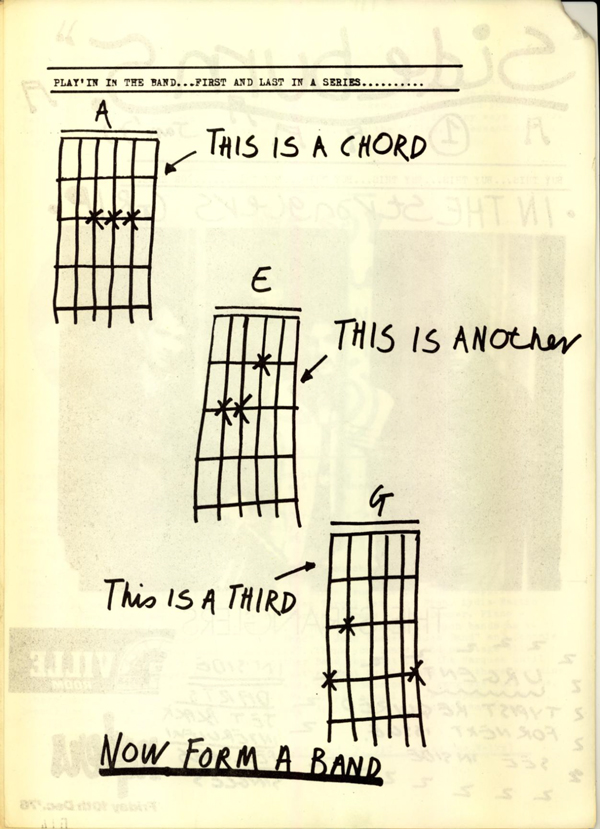
"CREATIVE 2 PROFESSIONAL: 7 Things to Think About" is based on a lecture commissioned by Aily Nash and Andrew Norman Wilson as part of Image Employment at New York's MoMA PS1. Read the curators' afterword here.

#1: Scot Halpin
In 1973, the rock band The Who were opening their US tour for Quadrophenia with a sold-out concert at the Cow Palace outside of San Francisco.
Halfway through their set, drummer Keith Moon passed out on his drums, allegedly due to a mixture of animal tranquilizers and brandy. After unsuccessfully trying to revive him, the band soldiered on drumless for a few songs. Eventually, Pete Townshend, The Who's guitar player and main songwriter, asked the crowd if anyone could play the drums.
After some egging on from a friend, Scot Halpin, 19 at the time and standing in the front row, volunteered. He filled in for four songs before the show ended. In this moment, Scot crossed the threshold from audience to rock star. He became a bit of hero among rock fans, even earning a special award from Rolling Stone magazine in 1973 for "Pick-up Player of the Year."
In a 1996 interview with the San Francisco Examiner, Scot said of the experience that it was "one of the few times you could play royalty."

#2: A page from the 1977 zine Sideburns
This page from a 1977 issue of London-based punk zine Sideburns has become somewhat iconic as a distillation of punk's early ethos. The idea was one of de-professionalization: not only that you, the fan, could become a performer, with no divide between you and the musician on stage, but also that you should do so, that your voice was worthwhile.
This image and idea can be compared and contrasted with Apple's home studio software Garageband, and its marketing campaign. In text on the webpage for GarageBand, Apple states:
With GarageBand, you have all the instruments, bandmates, and talent you need.
You don't need a studio full of big, expensive amps to play like your heroes.
And further down the page, describing the software's "Jam" function: "The roadies have set up. The band is ready to jam on a full-screen stage. Now pick your instrument and step into the spotlight."

#3: Beamz
Similar to Apple's promotional language around GarageBand, Beamz was touted as a device that let you "be a one-man rock band" and "be a hero." The device allowed you to alter pre-recorded music by waving your hand across a light beam.
While your movements would do something, you couldn't play a wrong note or off-time rhythm. It was targeted towards people who wanted to feel like they were making music, but lacked the skill. It relied on a specific idea of agency in making music, one that was rooted in mimicking the physical act of playing, much like playing air guitar.
This infomercial and the original Beamz model debuted in 2008 to much internet-based public mockery. Since then, Beamz has shifted their focus and marketing campaign. They have enlisted pop musician Flo Rida as spokesperson for their "Beamz by Flo," a version of the device that allows users to riff on "20 interactive songs inspired by some of the world's greatest artists—Flo Rida, Adele, Taylor Swift, Coldplay, Michael Jackson, Justin Timberlake, Pink, Lady Gaga, Carrie Underwood and many more."
They have traded in their original market of middle-aged males for young teens. In parallel, they have marketed Beamz as an educational device, "An Interactive Music Experience That Enriches Learning and Promotes Healing," targeted towards early-childhood educators, those in the fields of therapy and rehabilitation, and seniors.

#4: Paint-by-Number
Paint-by-Number kits were invented in 1950 by Max S. Klein, an engineer and owner of the Palmer Paint Company of Detroit, Michigan, and Dan Robbins, a commercial artist.
In 1951, Palmer Paint introduced the Craft Master brand of Paint-by-Number kits to the American public. They allowed the user to paint over a coloring book-style black-and-white illustration using special numbered paints. Each area of color in the illustration contained a number corresponding to a paint color, allowing the user to create a painting as long as they could stay inside of the lines.
Each Craft Master paint-kit box top proudly proclaimed, "A BEAUTIFUL OIL PAINTING THE FIRST TIME YOU TRY."
The above images are both designed and painted by Dan Robbins, co-creator of Paint-by-Number.

#5: The Prosumer
Prosumer is a word with many loose definitions, uses, and meanings.
In 1980, Alvin Toffler coined the term in his book The Third Wave. His definition was based on a portmanteau of producer and consumer, pointing to a new era in which consumers would help design and improve the goods and services of the marketplace. Products would no longer be mass-produced, but instead customized to the individual needs and desires of the consumer.
More recently, the term has been used as a portmanteau of professional and consumer, commonly referring to a certain grade of technical gear—often cameras and A/V equipment—whose intended consumer base blurs the line between professional and amateur: high-end hobbyist, or low-end professional.
A third use of the term stems from Toffler's original producer / consumer portmanteau, but refers instead to the idea of the consumer as cultural producer.
These various definitions seem to exist in the gray area between Sideburns's "here's three chords, start a band" and Apple's "You don't need a studio full of big, expensive amps to play like your heroes."
#6: The Ken Burns Effect
In 2003, Apple introduced a feature called "The Ken Burns Effect" to their consumer-grade video editing program, iMovie. The feature was named after the documentary filmmaker's ubiquitous use of slow pans and zooms over still photographs. It allowed the user to easily emulate Burns's signature style.
With this feature comes a readymade affect, bringing a particular gravitas to whatever content it is used with.

#7: Envato
Envato is an internet-based network of sites dealing with creative digital software and their products. They describe it as a "Creative Ecosystem":
Envato's ecosystem of sites includes digital marketplaces, an educational platform, a group of blogs, a design gallery and a freelance network. These services help millions of people around the world get creative, earn an income online, and learn new skills.
The marketplace sites are broken down into specific media and types of digital assets for sale, each with a pseudo-geological or ecological name:
Themeforest for Wordpress themes;
GraphicRiver for digital illustrations, templates, and graphic software plug-ins;
Codecanyon for programming "scripts and snippets";
Videohive for stock footage and video templates;
Photodune for stock photographs;
3DOcean for 3D models and textures;
AudioJungle for sound effects; and
ActiveDen for Flash files.
While Envato describes the marketplace as a platform for creative individuals to sell their wares, thus making an income off of their passion—à la, say, Etsy—the aesthetics and form of the material for sale are clearly aimed at commercial clients.
These products of creativity, then, are ultimately destined to be employed in the service of selling yet another product, a link in a complex chain of exchange, labor, and desire.
Image Employment is a research project investigating various modes of contemporary production that took the form of a moving image exhibition comprising four screening programs at New York's MoMA PS1 in September and October, 2013. The selected videos in the Dream Factory program examine new forms of labor, consumption-as-production, and the aesthetics and visual language of globalized "lifestyles." Michael Bell-Smith's video De-employed addresses this relationship between consuming and producing through the use of "prosumer" tools to perform a corporate commercial aesthetic. With his structuralist approach, Bell-Smith pushes the boundaries of these templates, interchanging sensationalistic content in the service of readymade affect, paralleling the way in which media today—music, movies, tv shows, news—are endless variations on structural templates.
For our Image Employment: Overtime Sunday Session at MoMA PS1, we invited Michael to present a new lecture, "Creative 2 Professional." It has been reworked for publication, above.
— Aily Nash & Andrew Norman Wilson, curators


Hi, Michael,
It's tempting to call this essay "7 Things in Search of a Stance"; what is your point exactly? Amateurism is bad? Prosumers are victims, and you, as a professional new media artist, are above all that?
It's fine if you want to inform us of some recent products that exploit creative hopefuls but what is the point of tracing this back to '70s rock and roll examples?
The Scott Halpin story fascinates because, for a brief glorious time, he had the skills to "step up" and substitute for Keith Moon. Townsend asked if anyone in the audience was good, not whether someone in the audience had a dream of playing with famous rockers.
The punk "three chord" example reacted to the professional excesses of progressive rock, with its symphonic scores and complicated time signatures. The punkers were saying anyone can do it, but as a means of promoting energy and angst in the face of irrelevant refinement. You still had to be "good" in your soulful rage.
None of this has any bearing on "no skills are necessary" phenomena such as paint-by-numbers or Beamz.
The Andrew Norman Wilson-style Olympian art view of pathetic little people "employed in the service of selling yet another product" exasperates.
An essay about how you (as artist) did something interesting with an amateur-aimed process might be more viable than creating this chain of non-causation.
Best, Tom
Hi Tom,
I'm going to make a note to come back and star this comment if we ever introduce that feature at some point in the future. So relieved that someone got upset by our use of a listicle.
But, I also disagree with your characterization of Mike's perspective; examples 3-7 are all focusing on companies (not users/"pathetic little people"); all of these companies want to sort of structure people's desire to express themselves in more truncated ways than those available to Scot Halpin or the punks.
I think the point of putting these two facets of amateurism (celebrated amateurs v commercial structures designed to enable amateur creation) in dialogue would be to suggest that there was some element of punk and the celebration of the amateur which has fed into the emergence of these rather depressing structures, and maybe Mike's recent practice has involved trying to identify more with the pathetic user than the Scot Halpin or the Ramones, because in our current context these kinds of figures have been so thoroughly instrumentalized in support of the creative class system of digital serfs and vassals (to borrow Jesse Darling's terms).
In contrast with Jesse, though, Mike seems more specifically interested in the implications of tools and structures offered to the "pathetic little people" rather than the people themselves.
michael
“What cultured people want, in terms of language (and thought), is to be well-defined, correctly positioned in strictly combined terms, and this is what they call good speech, good thought, and good writing. But they do not realize that they are thereby creating a closed circuit that leaves no room for anything but what was there in the first place—except for the decomposition inherent to all closed circuits, like moss that grows in a hermetically sealed jar.” (Dubuffet 1989)
Hi, Michael (Connor),
As editor you interpreted the list a certain way and felt it worthy of putting up. I can't speak to how Bell-Smith is employing these tools or whether that justifies this list – some additional explanation is necessary in the post itself. Every artist identifies with the punks against the Man and I'm sure Bell-Smith does. He's somewhat tainted in my view by the Andrew Norman Wilson frame. This was a person who worked on the Google campus, exposed some shoddy class stratification, and then, on being fired, said, in effect, "ta ta, I'm off to art school to deconstruct you guys – enjoy your miserable lives in the rat race." And then has made piece after piece from the perspective of a scientist studying lab rats of the digital economy. This makes it hard to say, about Michael Bell-Smith, "No, he's really one of you and totally comes from an exploited position." As he is being feted as a new media Brain in top New York institutions. It smells wrong, somehow.
I'll continue to insist that paint by numbers is not being sold by the Man for the little people to make punk statements – it's just a craft or toy or amusement.
–Tom